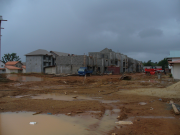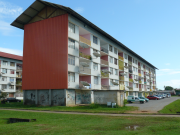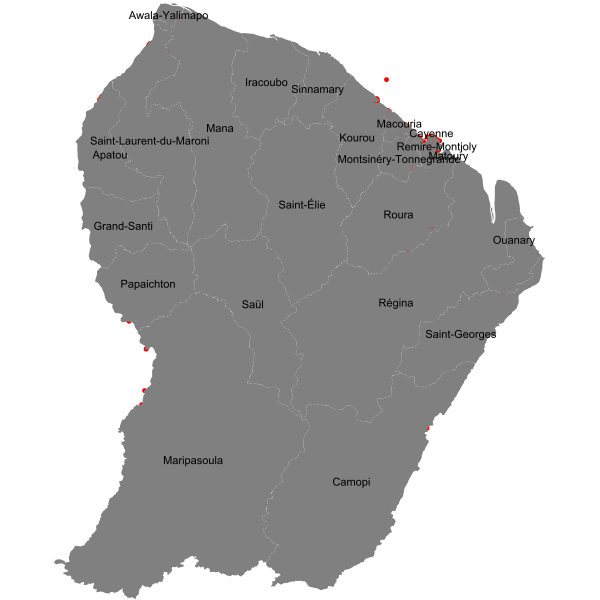structure
Type of resources
Available actions
Topics
Keywords
Contact for the resource
Provided by
Years
Formats
Representation types
Update frequencies
status
Scale
Resolution
-
Inventories of insects in French Guiana, mainly ants, spiders, Lepidoptera in order to study the biodiversity and distribution of terrestrial arthropods in French Guiana. 11 sites all over French Guiana are represented, 13 focal groups and more than 2600 taxa are represented. The ArthroEcoFoG database gathers more than 27000 specimens in 2016.
-

The UMR EcoFoG possesses several servers of administration or calculations. All are situated within the building INRA, office 207, of the Agronomic Campus of Kourou, French Guiana. The servers of calculations are: 1. Carapa, Tabebuia and Amandier: servers of calculation under Linux (Ubuntu), each possesses a server RStudio which allows to throw calculations under R from a Web browser (Firefox rather). 2. Wanakouali : His use is reserved for the supercomputing under Windows. His storage capacity is reduced (400 Go) but its hard drives are very fast. Installed softwares : R, Révolution R, RStudio, Tinn-R, OpenBUGS, MATLAB.
-

The general objective of the works led by the laboratory Biology of the Interactions is to contribute to the understanding of mechanisms at the origin of and which underlie the biodiversity through the study of the interactions between species. These interactions between species represent one of the important dimensions of the biodiversity because they establish the mechanisms which bind the elements of the biodiversity between them. This laboratory is situated on the Agronomic Campus of Kourou, French Guiana, within the buildings INRA of the UMR EcoFoG. Our research activities concern community assembly rules and the ecological adaptation and the plasticity of species traits in answer to the variations and to the constraints of their biotic and abiotic environment. These works lean largely on field studies in an integrative approach associating chemical, behavioral, molecular ecology and functional perspectives. The privileged models of study are leaf litter ants and the networks of mutualist interactions between insects, plants and microorganisms, such as associations between ants, plants and fungi and the trophic aquatic networks of phytotelmes. The interactions of predation and competition are also studied, with ants as main model, through the quantification of the functional processes in which these organisms are involved and of the biochemical and structural characterization of venoms, in a fundamental and applied perspective. This lab possesses: • Binocular loupes (Leica : S8APO (x2), S6T, MZ75, M80 - Wild : M5) with cold-light source (col de cygne), acquired in 2010, they allow the observation of samples of small sizes, with progressive zoom (7,5x à 60x) with a maximal height de 7,5 cm (for S8APO). Object field from 3 cm to 3 mm, according to the zoom level. • Microscope Olympus BX51, acquired in 2010, 4x, 10x, 20x, 40x, 100x. • A macroscope Leica Z16 APO (fully apochromatic zoom system for high contrast, high-resolution, detailed analysis) installed on a single beam path providing 2D images and ensuring parallax-free imaging. The lab uses 0.5x, 1x and 2x objectives, allowing a maximum magnification of 230x and a digital camera DFC450 (max resolution : 2560x1920). • Lyophiliser Alpha 1-2 LD, acquired in 2010. • Heating chamber, acquired in 2013, to maintain samples between 30 and 80°C. • Extractor hood (Sorbone), acquired in 2012, to manipulate toxic products.
-
This dataset summarizes the facilities that can be used within labex CEBA for the scientific work.
-

Emprises des opérations de logements locatifs sociaux en projet localisées avec les principales caractéristiques (variables selon le niveau d'avancement et les bailleurs). Un rapport d'étude complet comprenant des fiches descriptives de chaque opération en projet est disponible en téléchargement sur le site de l'AUDeG : http://www.audeg.fr/ressources/zoom_ressource.asp?id=80&srub=3&ssrub=1
-

Représentation numérique des emprises des opérations de logements locatifs sociaux existantes et en projets avec les principales caractéristiques (nom du groupe, nombre de logements, mode de financement, année de livraison ou année de livraison prévue...). Un rapport d'étude complet est disponible en téléchargement sur le site de l'AUDeG
-
Bâtiments présents en 2015 et n'ayant pas fait l'objet d'un permis de construire autorisé. Ce recensement a été fait dans le cadre de l'étude "Urbanisation spontanée" (AUDeG, 2018) menée sur les communes de Cayenne, Kourou, Macouria, Mana, Matoury, Montsinéry-Tonnégrande, Rémire-Montjoly, Roura et Saint-Laurent du Maroni. L'étude s'accompagne d'un rapport d'analyse en téléchargement sur le site web de l'AUDeG.
-
Bâtiments présents en 2011 et n'ayant pas fait l'objet d'un permis de construire autorisé. Ce recensement a été fait dans le cadre de l'étude "Urbanisation spontanée" (AUDeG, 2018) menée sur les communes de Cayenne, Kourou, Macouria, Mana, Matoury, Montsinéry-Tonnégrande, Rémire-Montjoly, Roura et Saint-Laurent du Maroni. L'étude s'accompagne d'un rapport d'analyse en téléchargement sur le site web de l'AUDeG.
-

Emprises des opérations de logements locatifs sociaux existantes localisées avec les principales caractéristiques (nom du groupe, bailleur, nombre de logements, mode de financement, année de livraison...). Un rapport d'étude complet comprenant des fiches descriptives de chaque opération est disponible en téléchargement sur le site de l'AUDeG : http://www.audeg.fr/ressources/zoom_ressource.asp?id=80&srub=3&ssrub=1
-

Les installation classées pour la protection de l'environnement (ICPE) regroupe toute exploitation industrielle ou agricole susceptible de créer des risques ou de provoquer des pollutions ou nuisances, notamment pour la sécurité et la santé des riverains. Les activités relevant de la législation des installations classées sont énumérées dans une nomenclature qui les soumet à un régime d’autorisation ou de déclaration en fonction de l’importance des risques ou des inconvénients qui peuvent être engendrés : Déclaration : pour les activités les moins polluantes et les moins dangereuses. Une simple déclaration en préfecture est nécessaire Enregistrement : conçu comme une autorisation simplifiée visant des secteurs pour lesquels les mesures techniques pour prévenir les inconvénients sont bien connues et standardisées. Ce régime a été introduit par l’ordonnance n°2009-663 du 11 juin 2009 et mis en œuvre par un ensemble de dispositions publiées au JO du 14 avril 2010. Autorisation : pour les installations présentant les risques ou pollutions les plus importants. L’exploitant doit faire une demande d’autorisation avant toute mise en service, démontrant l’acceptabilité du risque. Le préfet peut autoriser ou refuser le fonctionnement. La base contient les installations soumises à autorisation ou à enregistrement ainsi que les installations à déclaration qui ont été renseignées dan le système d'information de l'inspection des installations classées (en construction, en fonctionnement ou en cession d'activité).
 Guyane-SIG
Guyane-SIG